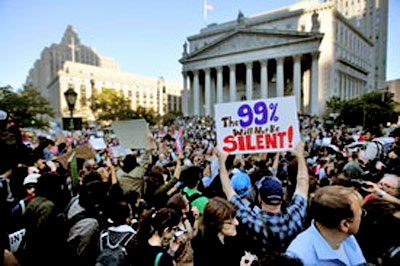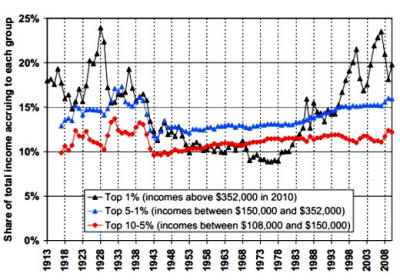
by Common Dreams
March 6, 2012
from
CommonDreams Website

In the wake of
the financial crisis of 2008 and
the recession that followed, huge numbers of US workers lost their jobs,
homes were lost to foreclosure, and most found themselves in the most
precarious economic shape of their lives.
Now, in a new report, evidence shows that as an
economic recovery (slight as it was) appeared on the scene, nearly all of it
went, not to those struggling, but to the very wealthiest of Americans, many
of whom helped lead the economy off the cliff in the first place.
According to a new report, nearly 93% of the economic gains made from 2009
to 2010 went to the wealthiest 1% of Americans.
"Top 1% incomes grew by 11.6% while bottom
99% incomes grew only by 0.2%. Hence, the top 1% captured 93% of the
income gains in the first year of recovery," reads the report by
Emmanuel Saez titled
Striking It Richer - The Evolution of Top Incomes
in the United States.
"Such an uneven recovery," writes Saez in
the report, "can possibly explain the recent public demonstrations
against inequality."
And continues by detailing some of the
historical context of wealth disparity in the United States, from early part
of the 20th century to the present:
The top percentile share declined during
WWI, recovered during the 1920s boom, and declined again during the
great depression and WWII.
This very specific timing, together with the
fact that very high incomes account for a disproportionate share of the
total decline in inequality, strongly suggests that the shocks incurred
by capital owners during 1914 to 1945 (depression and wars) played a key
role.
Indeed, from 1913 and up to the 1970s, very top incomes were
mostly composed of capital income (mostly dividend income) and to a
smaller extent business income, the wage income share being very modest.
Therefore, the large decline of top incomes
observed during the 1914-1960 period is predominantly a capital income
phenomenon.
Interestingly, the income composition pattern at the very top has
changed considerably over the century. The share of wage and salary
income has increased sharply from the 1920s to the present, and
especially since the 1970s.
Therefore, a significant fraction of the
surge in top incomes since 1970 is due to an explosion of top wages and
salaries.
Indeed, estimates based purely on wages and salaries show that
the share of total wages and salaries earned by the top 1 percent wage
income earners has jumped from 5.1 percent in 1970 to 12.4 percent in
2007.
A telling chart:

Alexander Eichler, writing at Huffington Post,
observes:
Saez's findings suggest that even though the
recession
dealt a blow to the 1 percent, it did little to push the U.S.
off the path it's been on for decades - that of a
vast and growing
disparity between the richest and poorest citizens.
Income for most workers has barely risen in the last 30 years, but the
top 1 percent of earners have seen their income almost triple in the
same amount of time.
Economists and other experts say that could be the
result of any number of factors, including the
decline of labor unions,
the explosion in capital gains during the middle part of the aughts, and
tax policies put in place in recent years that favor the wealthy.
In his State of the Union address this past January, President Obama
called economic fairness "the defining issue of our time," perhaps
mindful of the growing number of voters who say they can't even afford
basic necessities like
food.
The wealth gap has been cited as a major concern for the
nationwide
Occupy movement, and research has suggested that income inequality might
be associated with the kind of underwhelming economic growth the country
has experienced for the past two years.


